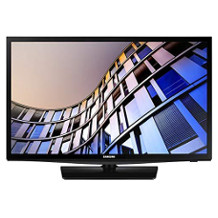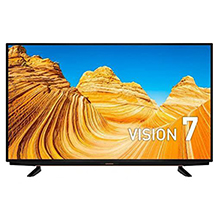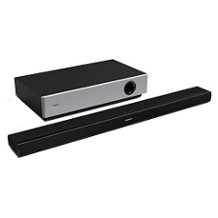4K TV purchasing advice: how to choose the right product
- What You Need to Know
- With their high image sharpness, brilliant colours and rich contrasts, 4K TVs offer breathtaking picture quality.
- The high pixel density enables an excellent picture even on XXL TVs.
- Even TV content that is not broadcast in 4K resolution appears better on 4K TVs than on Full HD sets.
- Pay-TV providers and video streaming services are increasingly relying on 4K, but broadcasters such as ZDF, RTL and ProSieben are also offering the first productions in this resolution.
4K: Pictures as sharp as never before
If you want a TV with impressive picture sharpness and colour, go for a 4K TV. Such a device offers the highest picture quality, even when the picture is very large. So 4K TVs are perfect for home cinema fans. Find out everything you need to know about 4K TVs here.
What makes 4K TVs stand out?
Modern 4K TVs are characterised by their strong picture quality. Among other things, it is made possible by the very high pixel density: 4K means that a screen has about 4,000 pixels on a horizontal line. Such a number allows even XXL TVs, such as 65- or 75-inch sets, to display images razor-sharp. Thanks to sophisticated technologies such as HDR and OLED or QLED, the events on the 4K screen also appear in a vivid blaze of colour and with rich contrasts.
The two most common resolutions in the 4K range are:
- UHD (Ultra High Definition), also referred to as “4K HD”, “UHD 4K” or “4K Ultra HD”: 3,840 × 2,160 pixels.
- Cinema 4K, also called “DCI 4K” or simply “4K”: 4096 × 2160 pixels.
The 4K televisions that now dominate the TV market are usually devices with UHD resolution. Their screen diagonals start at 40 inches and can measure 100 inches or more at the other end of the spectrum. The smallest 4K TVs are already available from just under 300 euros. The price range of UHD sets with a diagonal between 55 and 65 inches extends from around 400 to well over 6,000 euros. Even larger models can cost 15,000 euros or more, and customised models with special dimensions, such as 110-inchers, sometimes even run into the six-figure price range.
4K compared with HD ready and Full HD
With 1280 × 720 pixels, HD ready is recommended for smaller screen sizes. TV sets with this number of pixels come with the so-called HD-ready symbol, although sometimes the packaging only says “720p”. Today, they usually make up only a small part of the range offered by specialist shops and online shops.
Full-HD televisions are considerably sharper with 1920 x 1080 pixels. When they came onto the market, they effortlessly pushed the HD Ready models into the background. Full HD resolution offers very good picture quality for TVs up to 40 inches. Up to 50 inches, the picture is still good. Above this size, however, Full HD starts to weaken, so screens with the even higher resolutions 4K and – the latest craze – 8K have been developed.
Today, TVs with a screen diagonal of 50 inches or more almost always come with UHD resolution. In terms of production costs, there is only a small difference to Full HD models anyway.
Why is a 4K television worthwhile?
We often hear that there is hardly any UHD content on television yet. So why a 4K television? We explain why there are still good reasons for a UHD set.
The future belongs to UHD
Until recently, German TV channels broadcast all their content in Full HD at best. That has changed in the meantime. Occasionally, 4K content is now also produced for TV, for example ZDF’s Der Bergdoktor or the new episodes of ProSiebenSat.1’s classic Galileo Spezial. RTL has been operating the satellite channel RTL UHD since April 2018, which shows football matches and Formula 1 in 4K resolution, among other things. The pay-TV provider Sky offers two UHD sports channels that entice viewers with Bundesliga and Champions League broadcasts in top resolution.
How long it will take for the UHD standard to conquer the TV landscape on a widespread basis is uncertain. But the experts are unanimous: the revolution is coming. So if you have a 4K TV, you are ready for the future. By the way, there is good news for football fans: ARD and ZDF are planning to broadcast the matches of the 2022 World Cup in UHD.
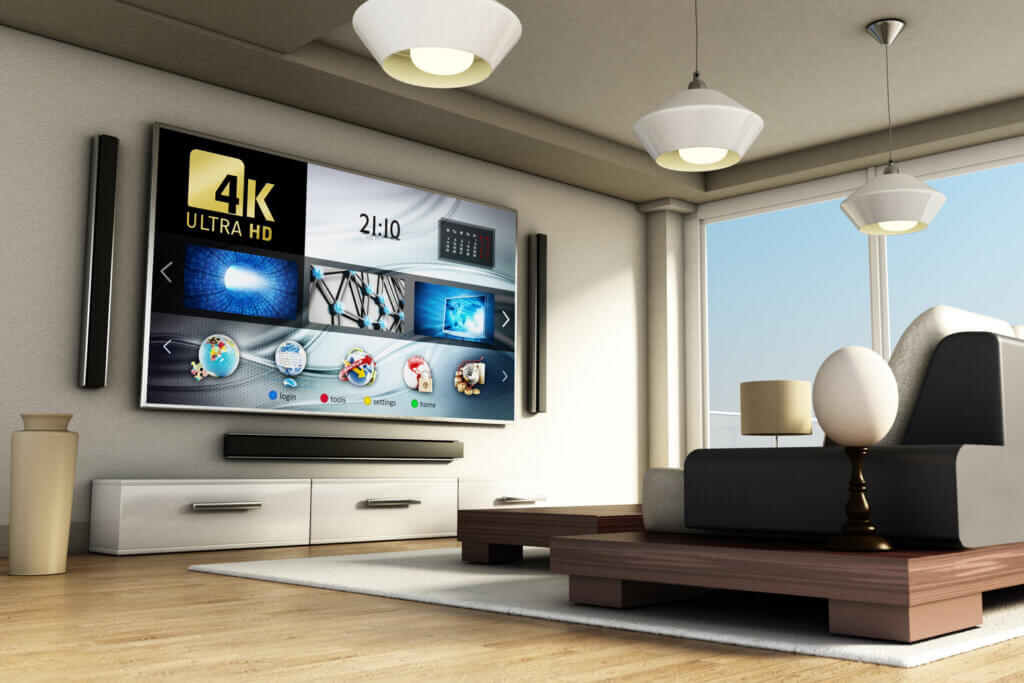
In video streaming services, the UHD revolution is already in full swing: The big names like Amazon Prime Video and Netflix are offering more and more 4K films and series. It should be noted, however, that streaming in UHD requires a sufficient internet connection. Netflix recommends a speed of 25 megabits per second. Those with such a connection can enjoy Netflix originals such as Better Call Saul or Dark in the highest picture quality.
The Blu-Ray sector also has a lot to offer in terms of 4K. Since Ultra HD Blu-Ray was introduced in April 2016, countless titles have been released in this disc format, including blockbusters from Warner Brothers and 20th Century Fox. Playing requires a special 4K Blu-Ray player, which is now available from around 150 euros. Those who own an Xbox One S or Xbox One X already have such a player, because with a special app, these consoles can also play Blu-Ray discs in 4K.
HDR ensures rich contrasts and fine colour nuances
The outstanding picture made possible by a modern 4K TV set is not solely due to the high pixel count. It is the technology of today’s 4K screens in their entirety that makes UHD TVs superior to lower-resolution TVs. Even if TV content is not offered in UHD, the picture on a 4K TV is better than on a Full HD model. A very important factor is that the so-called HDR technology is used almost exclusively in UHD TVs. HDR stands for “High Dynamic Range” and means that the TV set is able to display very strong contrasts and extremely fine colour nuances.
HDR is an extension of the contrast range SDR (“Standard Dynamic Range”), which no longer does justice to the possibilities of modern TV sets. Today’s models are capable of displaying 10-bit video signals, which means no less than 1,024 brightness levels. For comparison: on older TVs with 8-bit panels, a colour tone can appear in only 256 brightness levels. But it is only with the expanded brightness range that HDR offers that the potential of today’s TV sets can be exploited. The new contrast range gives the picture much more colour depth and makes it much sharper in detail.
There are currently four different HDR formats:
- HLG
- HDR10
- HDR10+
- Dolby Vision (DV)
They differ not only in terms of the number of brightness levels, but also in terms of the metadata, which – if used – is either dynamic or static. With dynamic metadata, the contrast values are calculated and adjusted individually for each scene, which makes the TV content look particularly realistic. In the static variant, the metadata is only transmitted once and thus remains the same for the entire video; this results in a certain loss of quality in very bright or very dark scenes. HLG and HDR10 are static formats, while the more sophisticated standards HDR10+ and Dolby Vision transmit dynamically.
HDR allows for rich blacks, and even neon colours look authentic on appropriate screens. If a scene is overexposed, for example by sunlight, the brightness is adjusted so that the image becomes sharper and reveals more fine details.
Upscaling: upscaling of images
Upscaling means that the TV adapts an image that has a lower resolution than the screen to the size of the display. Without upscaling, a blockbuster in Full HD, for example, would take up just 25 per cent of the screen area of a 4K TV and appear between wide black bars. Upscaling stretches the image by artificially increasing the number of pixels. In principle, there are two different methods for this: pixel repetition and bilinear intrapolation.
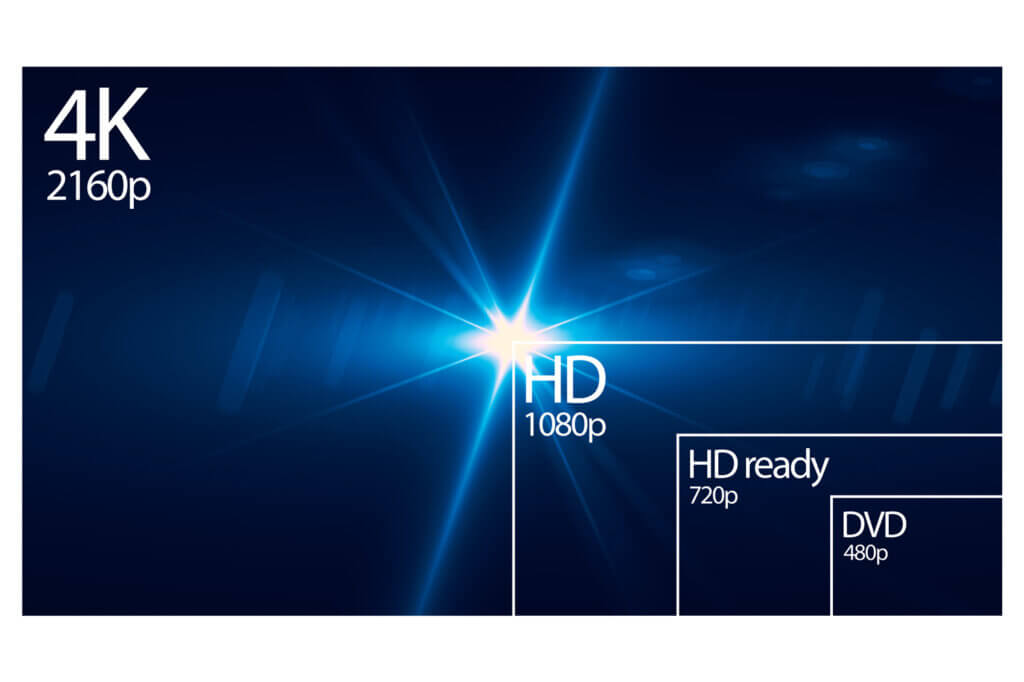
Pixel repetition is the simpler, but also less satisfactory variant. Here, the individual pixels are “copied” and then displayed in a higher number. A pixel is thus quadrupled, for example. However, the picture quality does not follow suit: The image appears pixelated.
Bilinear intrapolation, on the other hand, increases the number of pixels smartly. In its case, the average value between two neighbouring pixels is determined and the resulting pixel appears in the space between them. This makes the pixel transitions look much smoother. However, the picture is less sharp than in native resolution.
Upscaling technology is improving, but differs from manufacturer to manufacturer. The quality of the upscaling depends not only on the specific process, but also on the strength of the upscaling chip. An image upscaled to 4K may not quite match a native 4K display, but it often comes close. As upscaling technology continues to be refined, the loss in quality becomes smaller and smaller.
Finding the right 4K TV
Which 4K TV best meets one’s own demands and wishes depends on various factors. Among the most important purchase criteria are the screen size, the display technology (for example OLED or QLED) and the interfaces. You can find out what you need to consider here.
The screen size
4K televisions are available with a screen diagonal of 40 inches or more. Smaller displays also deliver a very good picture with Full HD, so UHD is not worthwhile with them. 4K screens inspire with a very sharp picture even on the particularly large TVs. Film and series fans who want a device with a large screen diagonal for their home cinema, for example a 75- or even 86-incher, therefore do not have to accept any compromises in picture quality.
When choosing the screen size, you must also consider the recommended seating distance from the TV. Here the resolution plays an important role: the higher it is, the closer you can sit to the set. A distance of one and a half times the screen diagonal is sufficient to prevent the pixel grid of a UHD picture from being recognised. If the 4K device has a 50-inch display, for example, the viewer can sit about two metres away without the picture appearing pixelated. By comparison, the recommended minimum distance for Full HD TVs is three times the screen diagonal and thus twice as large.
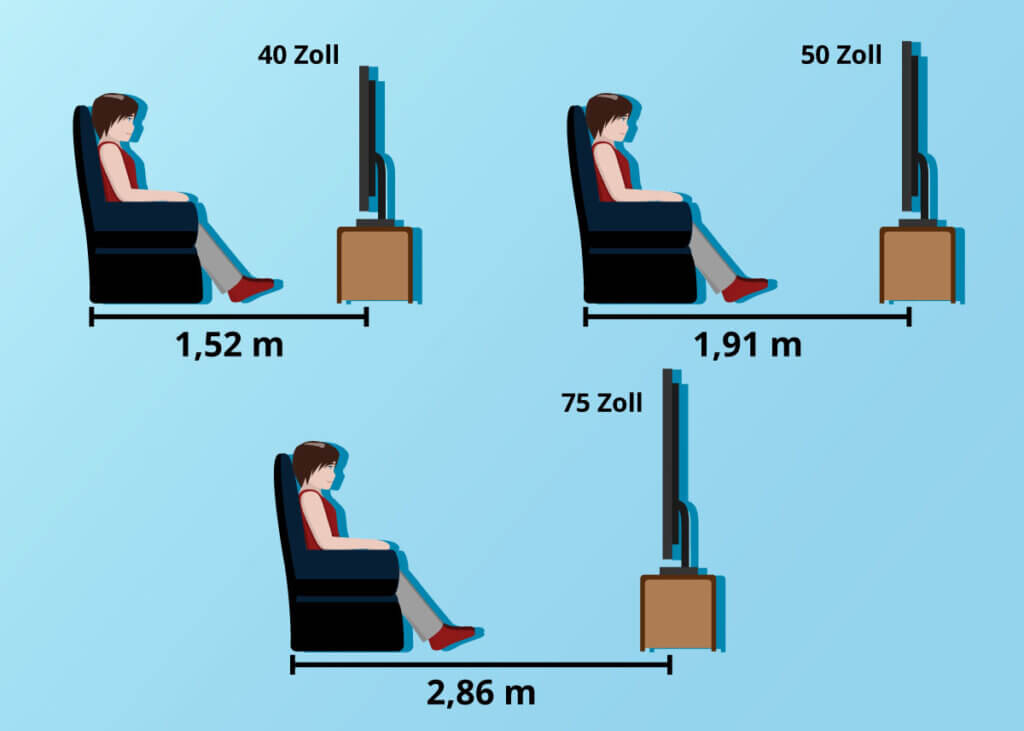
However, what distance is ideal for you depends, of course, on your subjective feeling. The only important thing to know is that a 4K TV gives you more leeway than a Full HD model, because in its case you can sit much closer to the screen without the picture quality suffering. This is particularly advantageous if the TV is to be placed in a small room that only allows a short sitting distance.
| Display diagonal | Seating distance |
| 40 inch | 1.52 m |
| 42 inch | 1.60 m |
| 47 inch | 1.80 m |
| 48 inch | 1.83 m |
| 50 inch | 1.91 m |
| 55 inch | 2.10 m |
| 60 inch | 2.29 m |
| 65 inch | 2.48 m |
| 75 inch | 2.86 m |
| 86 inch | 3.28 m |
OLED versus QLED
Two display technologies are currently considered the ultimate: OLED and QLED. The former was developed by LG, the latter is an alternative from the TV forge of Samsung. The two South Korean technology giants are on an equal footing here and are engaged in a relentless battle in the premium segment of the television market. It should be mentioned that other manufacturers are now also using OLED and QLED displays. Which type of screen is the better choice for you depends on the specific uses of the TV as well as your personal preferences.
How does an OLED screen work?
An OLED screen does not need a backlight because it has self-luminous pixels. They are a fine network of organic light-emitting diodes. The “O” in OLED stands for “organic”. The image is created when the light-emitting diodes are supplied with electricity and light up.
Are the organic light-emitting diodes in OLED TVs organic?
The assumption that the organic light-emitting diodes of OLED screens represent biological structures is a common misconception. “Organic” here simply means that they are carbon compounds. To distinguish them from crystalline LEDs, the term “plastic LEDs” would also be possible.
The advantages of OLED
OLED televisions come up trumps when it comes to black tones. They are able to display a rich pitch black that QLED models cannot quite match. OLED sets are also more responsive: the time it takes for their diodes to turn on and off is slightly shorter than Samsung’s Quantum Dots. OLED models are thus the better choice for gamers and action movie fans, because lightning-fast movements and scene changes require the TV to have the shortest possible response time.
Another advantage of OLED TVs is that the viewer can see the picture clearly from almost any angle. This is due to the self-luminous diodes, which emit light at a wider angle than is the case with backlighting. OLED sets are thus somewhat better suited to situations where a group of people is gathered in front of the TV and sometimes sitting at an angle to the screen – for example, when watching World Cup football matches together.
In addition, OLED models are generally somewhat more energy-efficient because they do not require a backlight. So fans of high-end TVs who want to keep their electricity costs as low as possible are well advised to go with them.
Who builds OLED TVs?
For a long time, only LG used its own OLED technology. In the meantime, however, many manufacturers are making use of it, including Philips, Sony and Loewe. Initially, the innovative technology with the self-luminous pixels pushed the prices of the sets up sharply. In the meantime, however, the price tags of OLED models are no longer a deterrent.
What is a QLED display?
QLED is a further development of LED technology. The “Q” stands for “quantum dots” and refers to the special nanoparticles that form an additional layer of the screen. Just like simple LED displays, QLED screens need backlighting. Their quantum dots refine the picture quality.
The advantages of QLED
QLED TVs impress with their high brightness values. They can display pictures much brighter than OLED models, and without the colours losing their power. In this respect, OLED TVs are already inferior to LED TVs, which for their part offer somewhat lower brightness values than quantum dot devices. In sunlit rooms, QLED sets cut a better figure than their OLED counterparts, because their brighter picture creates a smaller contrast to the room light and is thus easier to see.
Quantum dot technology also has the advantage that it prevents images from burning in. With OLED sets, burn-in is possible in principle. In practice, however, it only happens in very rare cases, because for a picture or at least a picture element – for example, a channel logo – to burn in, it must be shown for at least ten hours a day over many weeks. Modern OLED TVs also often come with protective mechanisms such as screen savers that prevent this from happening in everyday life. But if you still want to play it safe, choose a QLED model.
Who builds QLED TVs?
In the meantime, besides Samsung, Hisense and TCL also build QLED TVs. These three manufacturers call themselves the “QLED Alliance” and want to fully exploit the potential of quantum dot technology through targeted further development.
What does a 4K smart TV offer?
Almost all new TVs are smart devices. They can be connected to the internet via LAN or WLAN and thus offer the possibility of streaming videos, for example from media libraries or YouTube. Equipped with apps from paid video-on-demand services such as Amazon Prime Video, Netflix or Maxdome, smart TVs are also very attractive for film and series fans. Interesting for the topic of UHD TVs: Netflix, Amazon Prime Video and Co. offer some of their new content in 4K resolution – and the trend is rising.
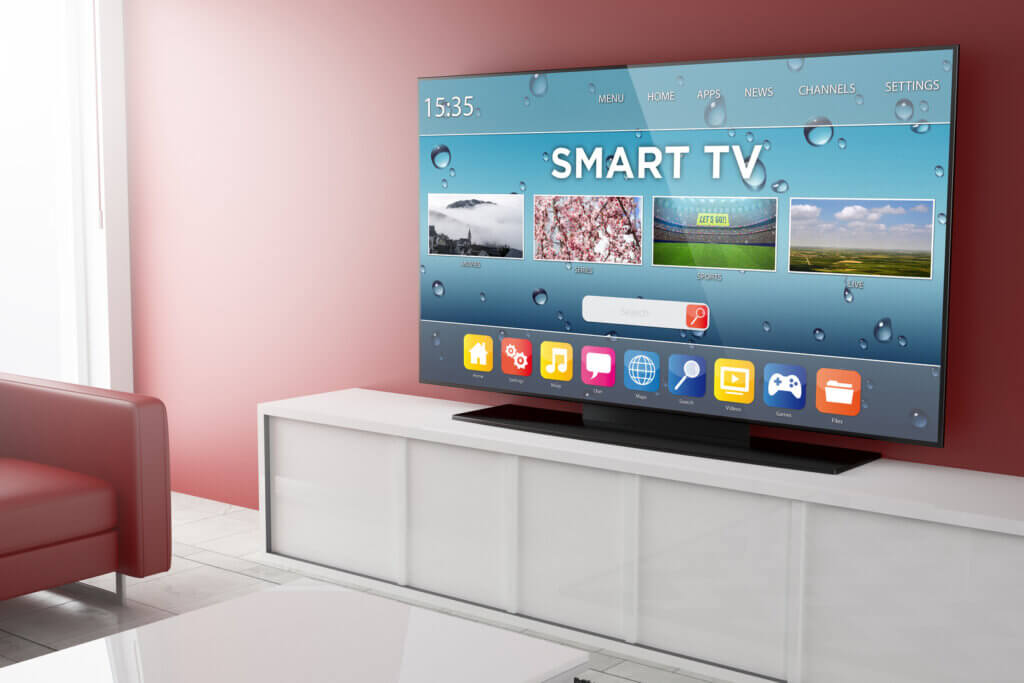
With smart TVs it is also possible to surf the internet. You can conveniently enter the web address via smartphone or tablet – if necessary, you can even connect a mouse and keyboard via Bluetooth. In addition, smart models score points with game apps and the option to wirelessly transfer your own videos and photos from your smartphone to them and show them on the big TV screen.
Critical voices have pointed out in the past that smart TVs can be misused as catch-nets for information about the owner. However, most experts give the all-clear: while data is indeed collected, it is mostly anonymous. On average, a smartphone reveals much more about its user.
4K curved TVs: an original alternative
When the first curved TVs came onto the market in 2013, they caused quite a stir. Their design attracted a lot of attention and created a wow effect. In the meantime, however, the hype has died down and the future of curved sets is hotly debated among experts. Whether such a device is worthwhile for one’s own four walls depends on how heavy the advantages and disadvantages of this specific design weigh with regard to one’s own needs. First of all, however, it is important for 4K fans to know: Since curved TVs are only found in the premium segment, they always have 4K resolution.
Among the advantages advertised by manufacturers is that concave displays harmonise better with the human eye’s field of vision than flat screens – in other words, ergonomics for the eye. At an ideal sitting distance, the viewer perceives the colours and contrasts at the screen peripheries in the same way as in the centre of the display, because the distance to all pixels is the same due to the curved shape. The picture appears larger and the picture depth appears greater.
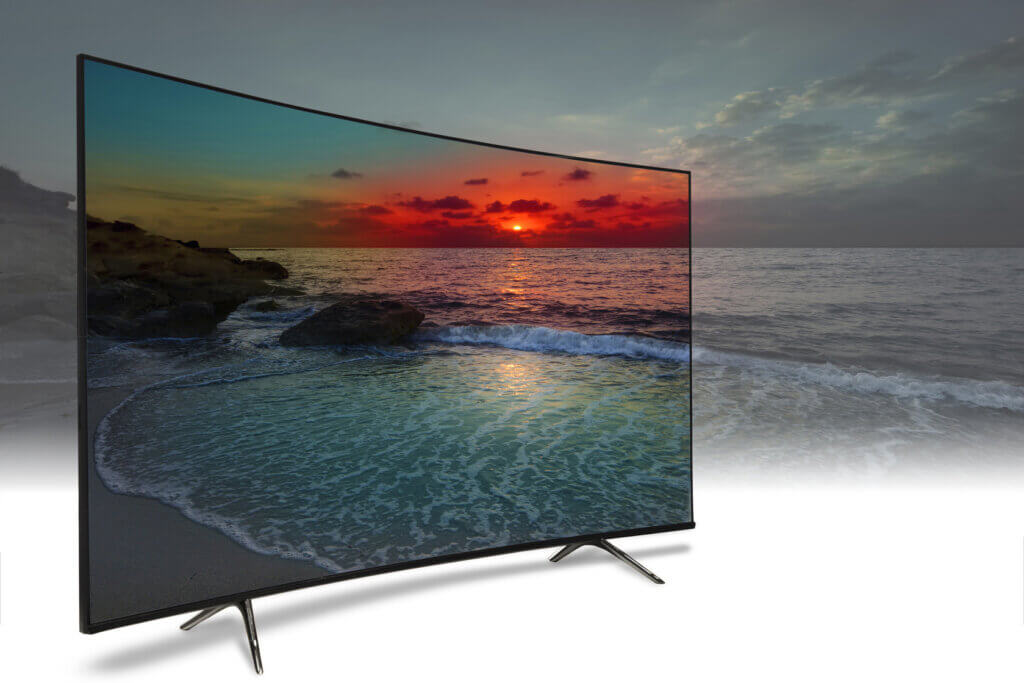
Curved TVs are, however, capricious: in order for the effect of the curved screen to unfold, the viewer must sit centrally and preferably very close in front of the TV. With seats that are only slightly to the side, the loss of colour and contrast is already clearly perceptible. Curved models are therefore less suitable for film evenings with family and friends. They are also more prone to reflections than flatscreens. For someone who is not bothered by this and likes to watch TV alone, however, they are a good and original alternative to the usual flat TVs.
Since the effect of a curved design is too small for small and medium-sized screens, the display diagonals of curved TVs only start at 49 inches. Most models are 55- or 65-inchers. For the cheapest new sets, you have to put just under 500 euros on the counter.
Which interfaces should be on board?
The type and number of interfaces vary from TV to TV. For those interested in buying, it is therefore not always easy to make the right choice under this aspect as well. We present the most important interfaces and provide some help in making a decision.
HDMI
Modern 4K TVs have several HDMI connections as standard, although their number varies depending on the price range. Your new TV set should have at least two, preferably four of them, because you use them to connect the Blu-Ray player, the DVB-T2 receiver, the console, the computer and the surround system. If the HDMI interfaces are not sufficient, you may have to reconnect them again and again.
You should also consider which HDMI version the TV set supports. Many low-priced 4K TVs only offer the HDMI standard 1.4, which allows UHD content to be transmitted, but only at 30 frames per second. With very fast movements, this transfer rate occasionally results in jerks and streaks. With HDMI 2.0 or higher, on the other hand, it is 60 frames per second, which means a smooth display at all times and is even sufficient for 3D content. It should also be borne in mind that a current HDMI 2.0a is required for the TV to display HDR.
CI+ slot
A so-called smart card is inserted into the CI+ slot, which is used to activate encrypted private channels as well as classic pay-TV channels such as Sky for a fee. In contrast to the predecessor standard CI, CI+ enables high-definition reception, so you can watch Sat1, RTL, Pro7 and Co. in HD. All current televisions have a CL+ slot.
USB connection
You can connect USB sticks and external hard disks via a USB input. Films and series stored on external media can be played conveniently on the TV set. Well-equipped 4K TVs also offer the practical option of recording TV content to USB sticks or hard drives.
LAN, WLAN and Bluetooth
Internet-capable TVs always have a LAN port and often also include a WLAN module. These interfaces make it possible, among other things, to call up content from online media libraries, use video-on-demand services and watch YouTube videos. If the TV set also has Bluetooth, there is the convenient option of connecting a mouse and keyboard.
Which tuner do I need?
A tuner is a receiver that is built into the TV set. It filters out the broadcast signals that come via the antenna, cable or satellite dish. Older TV sets usually have a dual tuner, which means that they can only handle two types of reception, such as antenna and satellite TV. A triple tuner is better, however, because it opens up all three ways of reception – it includes antenna, satellite and cable TV. With a triple tuner, you are equipped for all reception options. If one of them is missing, you may have to use an external receiver with its own remote control. Triple tuners are standard for 4K TVs with a screen diagonal of 55 inches or larger.
Caution: Do not confuse dual tuners with twin tuners!
Sounds similar, but means something completely different: twin tuner is not a synonym for dual tuner. So “Twin” does not mean that a TV set offers two ways of reception, but merely indicates that transmission via two channels is possible at the same time. This is practical, for example, if you want to watch a programme and record a film at the same time.
How high should the refresh rate be?
The frame rate, also called the refresh rate, is an important factor for picture quality. It refers to the number of pictures a TV shows per second and is given in Hertz (Hz). If, for example, 100 hertz is written in the product description, it means that the TV set displays 100 images per second.
The signal transmission of TV channels, game consoles and Blu-Ray players is 50 to 60 hertz. TV sets that operate at a higher frequency insert intermediate images that they calculate themselves, for example one image between every two images. In this way, 50 hertz becomes 100 hertz. The higher refresh rate makes the picture more fluid and sharper in detail. This is especially important when there are fast movements, for example in sports broadcasts, action films or video games. Football fans, Vin Diesel devotees and gamers accordingly need TVs that deliver at least 100 frames per second.
A refresh rate of 100 hertz or higher is also recommended for anyone who wants a large 4K TV. The larger the screen, the more the sharpness decreases. For smaller TVs, 50 hertz is perfectly adequate – especially if you only watch “quiet” content, such as news, talk shows or daily soaps.
Some televisions “brag” about rates of 400 or even 800 hertz. At 200 frames per second, however, the human eye gradually reaches its limits – differences are barely perceptible, if at all, from this value onwards. So you don’t need an 800 hertz TV any more than you need a city car with a jet engine.

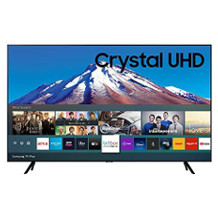
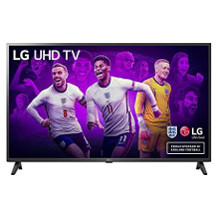
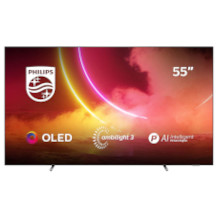
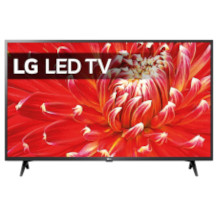
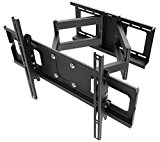
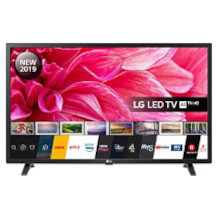

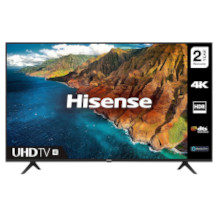
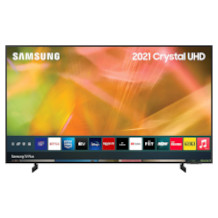
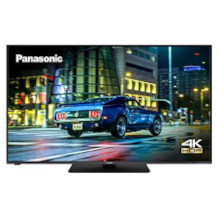
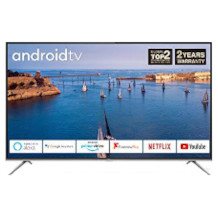
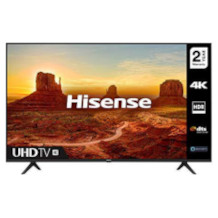
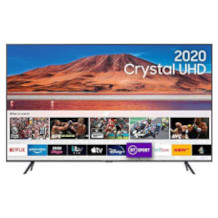
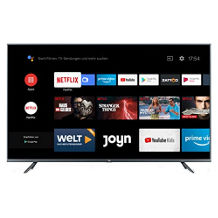

 1,758 reviews
1,758 reviews
